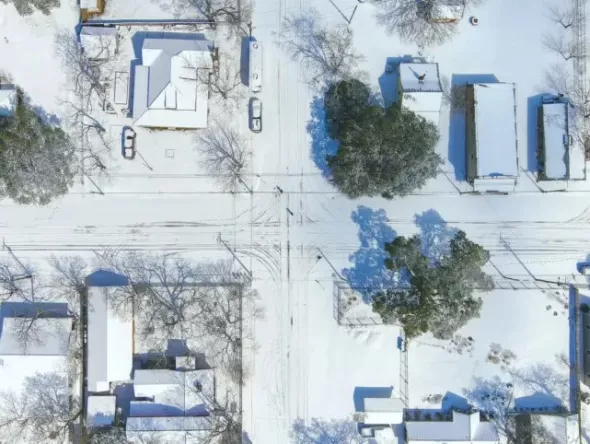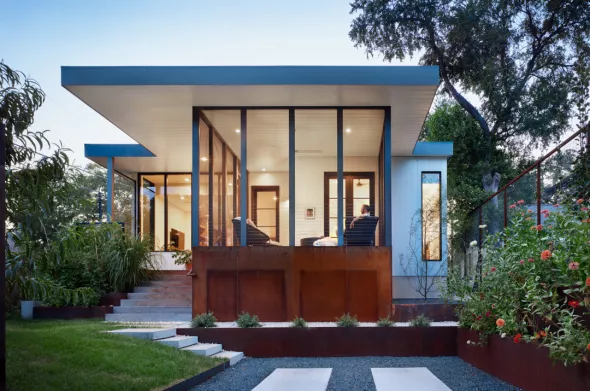Texas Take 2 -- Resilience
Phius professional Trey Farmer details his experience living in a Phius home during winter storms in Texas.
Phius professional Trey Farmer details his experience living in a Phius home during winter storms in Texas.
Last month, Texas got some immersion therapy to help us deal with the collective trauma lingering from the 2021 “Snowpocalypse.”
An arctic blast came through – another once-in-a-generation cold snap – just like the one we got two years ago that caused widespread grid failure throughout the state. You can read more about my family’s experience in our newly renovated passive house during the 2021 storm here.
Needless to say, when our Christmas weekend forecast showed six nights well below freezing, with temperatures falling to the low teens, there was some worry around town that we might lose power and/or water again. Compared to 2021, the days were going to be a bit warmer, the nighttime lows were a bit higher, and there were no predicted snow or ice storms. The word from that top was that we should be careful and bring our plants in, but no need for panic or hoarding.

At our house, however, there was an extra sense of security because we are lucky and privileged enough to live in one of the only Phius-certified homes in the South and the only one with Source Zero certification, which means that not only is our home incredibly healthy and comfortable even in extreme weather, it also powers itself and is designed to take whatever extreme weather throws at it.
During the 2021 storm, we lost power for more than three days, and our 6.5 kW PV array disconnected from our house and the grid to protect utility workers. Inside, our house was much more comfortable than our neighbors homes and offered an excellent additional data point showing the well-studied benefits of increased survivability in Phius projects. Still, it was frustrating knowing we had all that production potential on the roof sitting idle in the cold while I cooked breakfast on a camp stove in the snow.
So, in 2022, we ponied up for a backup battery. Freedom Solar, our local Sun Power distributor, had done a great job with our PV, and we asked them to come back and install a Tesla Powerwall. Our local municipally owned utility still doesn’t provide time-of-use rates, so until that changes, our battery is purely an insurance policy. My hope is that with more batteries and EVs connecting to the grid, we will get to put the battery to use in helping shave peak demand curves and green our grid.
What we learned during the battery system design was that a battery backup, a PV system and a certified Phius home make a great team. Most people with backup batteries either get one to just power their critical safety loads, or need to get many batteries to cover their full operating budget. Having an ultra-low load home, efficient systems and low start-up energy costs meant our backup battery could be small while still powering the home during everyday operation.

Our PV array is also designed to cover our total annual energy use, but is much smaller than what would be needed on a typical home. Combined, this means our PV array will fully charge our battery twice over in a single day, while also covering our daily energy use. When the power goes out, we will remain vigilant, but in theory, we don’t need to modify how we live – we can keep the lights and the heat on.
In the end, the cold snap came and went. The house was predictably comfortable and unfazed. It was damned cold outside (for Texas at least), but we had a nice long holiday weekend enjoying the ample daylight and views of our poor fruit trees, which struggled through the cold, but happily survived. The house never got stuffy despite how much time we spent inside, thanks to the constant supply of fresh filtered air brought in by our ERV. The PV provided most of our power for the week, but given these were the shortest days of the year, we were not quite net positive overall.
My biggest takeaway from the process of designing, building and now living in our home is that the Phius standard is truly the way forward in design. Our firm, Forge Craft Architecture + Design, has taken all that we learned with this and other passive house projects we’re working on and applied it to our project work in other practice areas – from affordable housing to modular and emerging construction technologies.
We believe so strongly in this approach that we made the call last year that all of our custom home work will be designed to the Phius standard going forward. It really is the benchmark the architecture, design and construction industries need to be using. The benefits are huge, and the costs are minimal and well worth it. Outside of the myriad health and efficiency benefits, the simple peace of mind knowing that my family is going to be safe and comfortable in our home even in extreme (and seemingly more frequent) weather events is invaluable.